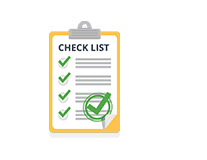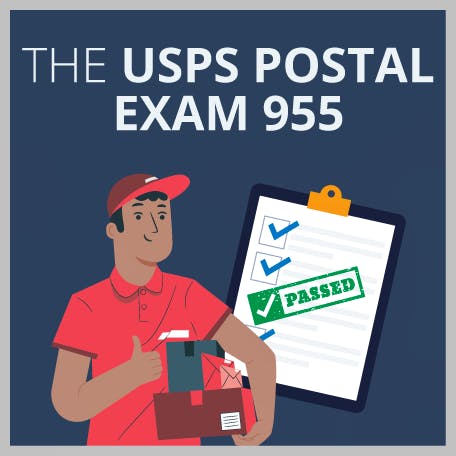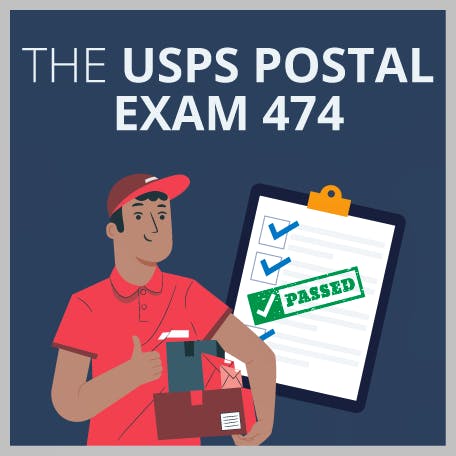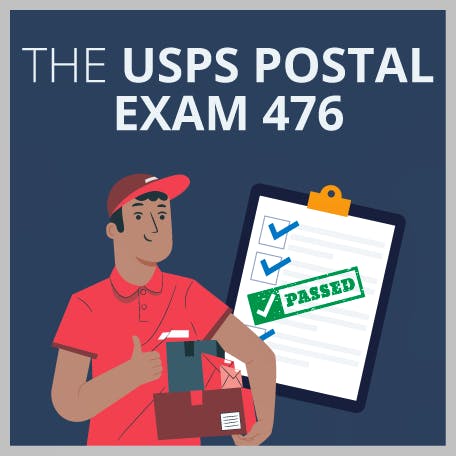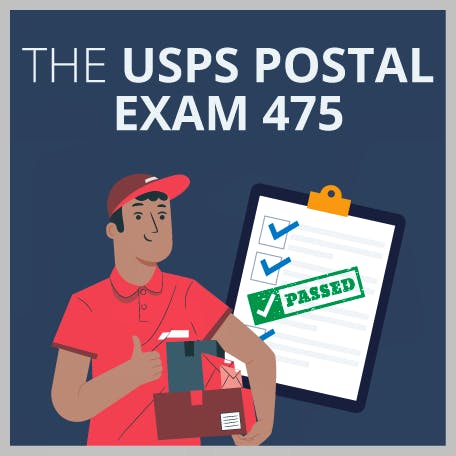The Ultimate Guide to the USPS (United States Postal Service) Exam (with 5 Practice Test Questions!)
Updated November 18, 2023

- What Are the USPS Exams?
- What Type of Questions Are Included on USPS Exams?
empty
empty
empty
empty
- What Are the Four Different Assessments?
empty
empty
empty
empty
- Process for Taking the USPS Tests
- Example Questions on the USPS Tests
empty
empty
empty
empty
- What Score Do You Need to Pass a USPS Test?
- How to Prepare for USPS Exams
- Frequently Asked Questions
- Final Thoughts

Those hoping to secure a career with the USPS (United States Postal Service) will likely face a USPS Virtual Assessment Exam.
These exams include a series of questions designed to test your cognitive ability and personality traits. Many of the questions are situation based, giving the employers an excellent insight into whether you would be a great fit for the role.
What Are the USPS Exams?
As mentioned, the USPS test is a crucial element of the hiring process for many positions at the Post Office. Depending on the specific position you have applied for, you may face the 474, 475, 476 or 477 assessment.
You might see references to the 473 postal assessment. However, this test is now obsolete and has been replaced by the four separate assessments mentioned above.
There are two critical factors that you must be aware of before starting the USPS test:
- You only have 72 hours to complete the assessment from the moment you receive the invitation.
- You must receive a result of 70 or above to be considered for the position.
Should you not comply with the above, this will result in immediate failure and you will not be able to re-sit the examination for a further 12 months.
What Type of Questions Are Included on USPS Exams?
Behavioral Questions
The sections titled work scenarios and help your customers both contain behavioral questions.
As the name suggests, behavioral questions are designed to understand how you will behave in the workplace.
Behavioral questions often feature a work-based scenario with a series of possible responses.
The key to success in these questions is thoroughly understanding what is expected of you in the role, which can be learned through analyzing the company website and job description.
Work Scenario
Work scenario questions feature in all four of the USPS tests.
The work scenario questions are a crucial element of the hiring process, demonstrated by the fact that they are present on each of the four USPS tests.
These exams will be similar to situational judgement tests you may have encountered in other applications. These types of questions are the most accurate way for a potential employer to understand how you will act in the workplace.
During these questions, you will receive a series of workplace scenarios. There will then be four following statements, and you must rank which action you would be most likely to take and which you would be least likely to take.
It is crucial that you are honest when answering these. At the same time, you must always consider the attributes that the employer is searching for, which will give you the best chance of securing the position.
Help Your Customer
Help your customer questions are only present in the 477 test.
You will only find the help your customer section on the 477 test as these questions directly relate to the situations you will encounter during your role as a customer service clerk.
Free postal exam 477 practice test questions can be found on JobTestPrep.
This assessment will test your logic and mathematic skills with real-world questions.
For example, you may receive a list of products with corresponding prices and discounts. You will be given a combination of items a customer wishes to purchase and asked to calculate the pre-tax bill.
Personality Questions
There are three portions of the USPS assessment that include personality-style questions:
- Describe your approach
- Tell us your story
- What drives you
This style of question assesses your personality to determine whether you are a good fit for the company as well as the specific role.
Describe Your Approach
Describe your approach is present in all four of the USPS assessments.
During the describe your approach questions, you will be given pairs of statements marked A and B. You will then have to choose one of the following options: ‘most like statement A’, ‘somewhat like statement A’, ‘somewhat like statement B’ and ‘most like statement B’.
As you can see, the four options can be confusing, so you must read and answer each one carefully.
Likely, you may not exactly resonate with any of the statements. In these circumstances, you should choose the option which most aligns with your actions and the ethics that the employer is looking for.
Here, the employer is also testing for consistency. It will be clear when marking if your answers are random and inconsistent, resulting in a low score.
Tell Us Your Story
Tell us your story also features in all four of the USPS tests.
This section of the assessment is a questionnaire based on your past work experiences.
This might include questions regarding your longest employment, any disciplinary action or periods of unemployment. These questions are merely factual and therefore require a relatively small amount of preparation.
Alternatively, this segment might include questions regarding how past employers or work colleagues would rate your actions or skills.
What Drives You
What drives you is also in all four of the USPS tests.
As the name suggests, this assessment section is a motivation test designed to establish what fulfils you in the workplace.
There will be a statement with two corresponding answers, and you will be asked to choose the one that most relates to you. Here, you must understand the nuances and demands of the specific role you are applying for.
For example, it would be unwise to state that you thrive while working as part of a team for a role that requires you to work entirely independently.
Math Questions
Work your register is only found in the 477 test, used during the assessment for customer service clerks.
As a customer service clerk, a considerable part of your role will be working directly with customers and handling their transactions. Work your register tests your ability to ensure customers get the correct change when paying using cash.
It is essential to practice your basic math skills before sitting this assessment. Remember, you are being tested on speed as well as accuracy.
Attention to Detail Questions
The sections with attention to detail questions are check for errors, move the mail and verify customer information.
High accuracy and excellent attention to detail are essential for a successful career with the Post Office.
Check for Errors
Check for errors features in tests 475 and 476.
The format of this test is straightforward. Candidates are asked to work through data pairs, marking whether each is an identical match or an error.
Often, there is only one number difference between the pairs, making this section challenging. Be sure to look out for strings of zeros, as it can be tricky to spot where an extra has been added.
Move the Mail
Move the mail can be found in exams 474, 475 and 476.
During this assessment, you will see various images of postal boxes or envelopes with addresses printed on them. There will then be four options of where to ‘sort’ this mail.
This portion of the USPS assessment tests your accuracy and ability to work at speed.
Verify Customer Information
Verify customer information is used in assessments 474, 476 and 477.
As with the other accuracy questions, verify customer information tests your ability to quickly and precisely spot errors, enabling the best customer service.
Here, you will be presented with two sets of customer information and asked to verify if they are the same. This information can include their name, current address, previous address and contact details.
What Are the Four Different Assessments?
As mentioned, the 473 test has now been discontinued. Instead, it was split into four different USPS postal examinations: 474, 475, 476 and 477.
There are many other USPS assessments, including the postal exam 955 which is used for mechanical roles such as an area maintenance technician, a building equipment mechanic or an electronic technician.
MC (474) – For Mail Carrier Roles
There is extremely high competition for mail carrier positions, and therefore completing as many 474 postal exam practice test questions as possible will ensure the best chance of success.
You can find free USPS exam 474 practice test questions online to help you prepare.
The postal exam 474 is divided into six sections (two of which were added in 2021):
- Work Scenarios (18 questions)
- Describe Your Approach (139 questions)
- Tell Us Your Story (37 questions)
- What Drives You (25 questions)
- Move the Mail (18 questions)
- Verify Customer Information (10 questions)
MH (475) – For Mail Handler Roles
The 475 test is divided into six sections (two of which were added in 2021):
- Work Scenarios (18 questions)
- Check for Errors (3 questions)
- Move the Mail (18 questions)
- What Drives You (25 questions)
- Tell Us Your Story (40 questions)
- Describe Your Approach (139 questions)
MP (476) – For Mail Processing Roles
The 476 test is divided into seven sections (three of which were added in 2021). Later in this article you will find example questions from a postal exam 476 practice test.
- Work Scenarios (18 questions)
- Check for Errors (3 questions)
- Tell Us Your Story (18 questions)
- Describe Your Approach (25 questions)
- Verify Customer Information (10 questions)
- Move the Mail (40 questions)
- What Drives You (139 questions)
CS (477) – For Customer Service Clerks
The 477 test is divided into seven sections (three of which were added in 2021):
- Work Scenarios (22 questions)
- Work Your Register (3 questions)
- Tell Us Your Story (39 questions)
- Describe Your Approach (139 questions)
- Help Your Customers (14 questions)
- Verify Customer Information (10 questions)
- What Drives You (25 questions)
Process for Taking the USPS Tests
If you have applied for a position which requires a USPS assessment, you should keep a close eye on your emails. In due course, you will receive an email with a link which takes you to the non-proctored assessment, valid for only 72 hours.
You can do this exam from a smartphone, tablet or computer. Any device with a big enough screen and a strong internet connection will be sufficient.
Following completion of the assessment, you will receive an email prompt asking you to log in to your online portal to find the results of your assessment. If you read eligible, you have secured a passing score and will proceed to the next stage of the hiring process. Unfortunately, if you receive an ineligible result, you will not be permitted to continue.
It may also be the case that you need to complete a proctored exam as part of the hiring process. This is an exam that is sat in a registered test center rather than at home. Should this be the case, you will be notified via email.
Carefully read the following statement.
It is the holiday season, and so your shift has been extremely busy. However, your lunch break starts in 10 minutes, and you are looking forward to relaxing for an hour. A customer comes in and asks you to check if she can redirect the shipment that she sent a while back. This task usually takes quite a long time and will delay your lunch break.
Choose which of the below answers is most like the action you would take, and which is the least likely.
a) Redirect her to the section of the USPS website where she can check for herself.
b) Since you have worked very hard today and it is approaching your lunch break, ask the customer to check with someone else.
c) Advise the customer it is a time-consuming task and ask her to come back later.
d) Although you hate to be late for your lunch, you ask the customer for the details of the shipment and enquire about the redirect. You also ask the customer if there is anything else you can assist her with.
Carefully read the following statement.
You have a new employee on your team. You notice that they have been taking many personal phone calls during work hours. This is a violation of company policy and it has dramatically impacted their productivity.
Choose which of the below answers is most like the action you would take, and which is the least likely.
a) Report the new employee to your supervisor.
b) Do nothing. You are not a supervisor or manager so it is none of your business.
c) Remind the new employee of the work policy, and highlight how this is affecting work productivity.
d) Have a quiet word with the new employee and politely ask him to stop taking personal calls during work hours.
Example Tell Us Your Story Questions – Postal Exam Practice Test
Example Tell Us Your Story Question 1
How would your most recent supervisor describe your communication skills compared to your co-workers?
a) The very best
b) Amongst the best
c) Significantly above average
d) Average
e) Needing improvement
f) Needing serious development
Example Tell Us Your Story Question 2
Have you ever received a disciplinary for bad timekeeping?
a) Yes
b) No
c) Not applicable – this is my first job
Example Tell Us Your Story Question 3
What is the longest time you have stayed in any of your former jobs?
a) Less than 6 months
b) 6 months to 1 year
c) 1 year to 3 years
d) 3 years to 5 years
e) 5 years +
Example Describe Your Approach Questions – USPS Practice Test
As mentioned, here you will be given various pairs of statements. You will then be asked to choose one of the following answers in relation to the statements.
a) Most like statement A b) Somewhat like statement A c) Somewhat like statement B d) Most like statement B
Example Statements Set 1:
a) I enjoy having variation in my working day and thrive with a variety of tasks.
b) I work best when I have a defined set of activities for the day.
Example Statements Set 2:
a) I always complete my responsibilities for the day.
b) I always go above and beyond what is expected of me.
Example Statements Set 3:
a) I enjoy having the power to make high-level decisions.
b) I like to listen to many different viewpoints when making decisions.
Example Statements Set 4:
a) I make a plan and stick to it.
b) I am a spontaneous person.
Example Statements Set 5:
a) I will help others once I have completed my work.
b) I will drop what I am doing to help others.
Example Statements Set 6:
a) I am not a driven or motivated person.
b) It is clear to me what my life goals are.
Example Statements Set 7:
a) I think co-workers should keep their feelings to themselves.
b) I am eager to learn how my co-workers are feeling.
As you can see, the questions are worded in an extremely convoluted manner. Be sure to read each statement carefully.
Example Check for Errors Questions
Are each of the following pairs an exact match, or do they contain an error?
a) 98896386 | 98896886
b) 10000969 | 10008969
c) 36986171 | 36986171
d) 99969021 | 99966021
What Score Do You Need to Pass a USPS Test?
To pass the USPS exam, you need a score of 70. This is the minimum requirement to secure the position and does not guarantee you a job.
If you receive a score of under 70, you will be ineligible to proceed to the next stage. You will then have to wait a minimum of 12 months before re-applying for the position.
Remember, you only have 72 hours to complete the USPS assessment from the moment you receive the invitation. Candidates who complete the assessment the soonest after receiving the invitation are placed first in line for employment opportunities.
This means even if you achieve an excellent score, you may have already been beaten to the opening by those who acted faster.
How to Prepare for USPS Exams
Step 1. Research the Process and Study Past Experiences
As you can see, the USPS test is somewhat unusual in its content and structure. In addition, there are many nuances involved with each individual assessment.
There are many forums where people discuss their experiences throughout the USPS recruitment process. Of course, people cannot answer specific questions, but these discussions offer excellent insight into what you can expect.
Step 2. Take a USPS Practice Test
Once familiar with the test format, you must become comfortable with the content. The best way to do this is by completing a USPS practice test. Although the questions will not be identical to those you’ll find in the actual assessment, a post office practice test will provide excellent insight into the style of questions and multiple-choice answers you will encounter.
The more practice assessments you complete, the better you will handle the pressure when you receive your invitation to sit a USPS assessment.
Step 3. Check Your Equipment
You only have 72 hours to complete the assessment from the moment you receive the invitation. Therefore, you must check your equipment when you apply for the Post Office position.
You should ensure that you have a peaceful area in your home where you will be able to complete your assessment free from distractions.
As well as this, you should have a strong internet connection, suitable equipment and charging cables on hand. It would also be beneficial to have a comfortable, ergonomic desk, which will allow you to perform at your best.
Step 4. Focus On Your Well-Being
In the days leading up to your assessment, your well-being is of paramount importance. You should work on cultivating a solid sleep schedule to ensure you are well-rested.
On the morning of the assessment, it is crucial that you have a healthy breakfast, as being hungry can dramatically impact your performance. Additionally, you should be well-hydrated and have drinking water on hand throughout the assessment.
The USPS test is an assessment used throughout the hiring process for the USPS (United States Postal Service). This assessment has four main variations, depending on the role you are applying for. Some positions may require you to sit more than one assessment.
The USPS test isn’t hard, and as long as you thoroughly research the process, you should have no trouble passing the assessment. Unfortunately, many candidates fail to complete thorough research and preparation, which can lead to disappointment.
The best way to prepare is to complete as many post office practice tests as you can. Practice examinations are the most thorough way to prepare for this type of assessment.
You will receive a notification via email that you need to complete the USPS assessment, which will be valid for 72 hours. Failure to complete the assessment within this time frame will render your application unsuccessful.
To pass the USPS assessment test, you must receive a score of 70 or above.
Unfortunately, if you fail the USPS test, you cannot immediately re-take the assessment. You can only re-take the exam for a second time after one year.
JobTestPrep has resources and USPS free test practice questions for each USPS assessment test.
Once your results are ready, you will receive an email notification that your account has been updated. You will then need to log in to the portal and see either an eligible or ineligible status.
Unfortunately, ineligible means you did not achieve a high enough score and will not proceed to the next stage. If you are successful and receive the eligible notification, you will proceed to the next stage of pre-hire requirements.
You must begin studying for the USPS assessment as soon as you complete your application. First, it is best to research and understand the test format before moving on to a post office practice test.
As you have seen, there are many elements to the USPS assessment. There are behavioral, personality and competency-based questions.
This depends on which of the assessments you will be completing. However, most candidates complete the assessment within 45 minutes.
This postal exam study guide should cover everything you need to know about the USPS assessment. JobTestPrep also provides guides and free practice postal exam questions.
Final Thoughts
The USPS is an excellent employer that offers great career progression opportunities for its staff. Therefore, it will come as no surprise that the recruitment process can be extremely challenging and requires thorough preparation.
There are two crucial factors you must remember. The first is that you only have 72 hours from receiving the invitation to complete the USPS assessment. The second is that you must receive a score of 70 or above to proceed to the next stage.
The prospect of the USPS assessment can be extremely daunting. However, with the right understanding and preparation, you can successfully secure an excellent role within the United States Post Office.









